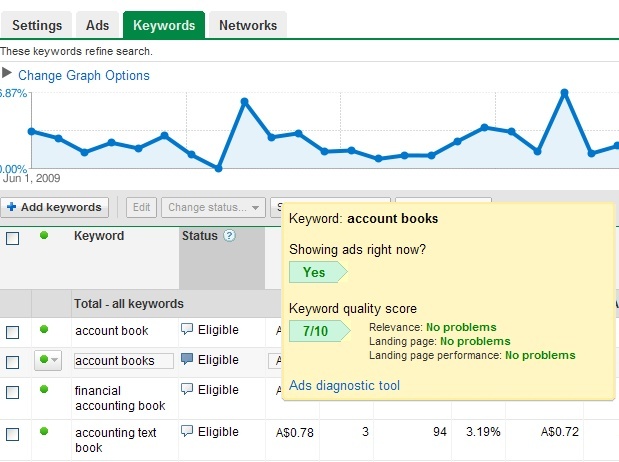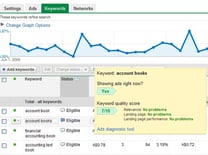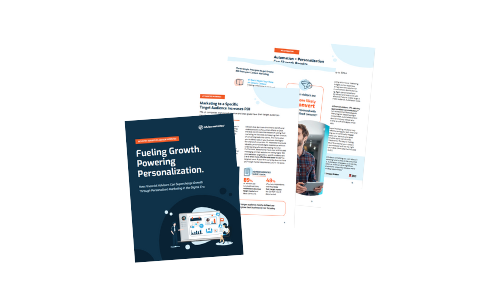Most ecommerce businesses use AdWords to generate traffic. In essence it's pretty simple - you bid for search terms in Google, your ad appears if someone searches for that term, and you pay only if someone clicks on that ad. It's a great system, but it does have a few traps.
Introducing Quality Score
How much you pay per click depends on many factors. A common misconception is that it's a simple auction - if someone is bidding 50 cents per click (cpc), a bid of 51 cpc will appear in the ad slot above. It's a bit trickier than that.
Google wants ads that are relevant. If the quality of the ads is higher, more people click them. Google assigns each advertiser's keyword a quality score between one (lowest) and 10. If you are paying 50 cpc and your ad has a quality score of 5, and your competitor is paying 40 cpc for an ad with a score of 8, it'll likely appear above yours, getting more clicks for less money. Getting your quality score higher is important.
The best way to increase your quality score is to increase your click-through rate (CTR). If your ad is viewed 100 times (called impressions) and clicked on twice, your click-through rate is 2 percent. Generally your click-through rate should be at least 1 percent.
|
|
To increase your CTR, you can have your ad shown less often, or clicked on more often. Let's look at both scenarios.
Negative Keywords
A common problem: your ad shows up for irrelevant search terms. If you are selling makeup, you might bid for the keyword "makeup." However, your ad will show up when someone searches for "makeup artist", "makeup classes", "makeup jobs," and many more. Someone looking for a makeup artist probably isn't interested in buying makeup, so you have increased your impressions needlessly and lowered your CTR. Adding negative keywords can reduce this problem.
Here's how you add negative keywords. Go into AdWords. At the bottom of your keywords screen you'll see + Negative keywords. Open this and add your negative keywords. You can choose ad group level but generally campaign level is better.
By adding lots of negative keywords you can decrease your impressions, and increase your CTR and your quality score. In this case, "artist", "classes" and "jobs" are good negative keywords. Here's a collection of generic negative keywords for inspiration.
Creating Ad Variations
Sometimes making small changes in an ad result in big changes in CTR. AdWords has a neat tool -- called Ad Variations -- that helps with this problem.
Go into your Ad Group in AdWords, and where you see ads, simply create another one. Google will automatically rotate your multiple ads to different users. Over time it will show the higher-performing ad more and the lower-performing ad less, increasing your CTR automatically. Start with two or three ad variations, and once there's a clear winner, use that one as the base for more variants.
Choosing the Right Pages
Many AdWords campaigns send all traffic to their homepage. You'll get a better result by pointing the ad to a specific page. The page you point your ad to is known as a "landing page."
For example, you run a bicycle shop. The word "bicycle" will probably go to the homepage. However, ads for the keyword "mountain bike" should point to your mountain bike page. This will almost certainly increase sales.
If someone searches for "Holstar Lightning Men's Mountain Bike", point them at the product page. The rule: always point ads at the most specific page. Yes, it's a bit more work to setup, but your sales will increase.
Choose the Best Words
Many people just bid for a few of the "big" words. For our bicycle shop example, the keyword "bicycle" would clearly be very popular. However, it would also be very competitive and expensive to buy, and generic words tend to result in fewer sales.
A better approach is to go for a large number of less popular words. Instead of five popular words, use 200 less popular ones. That sounds daunting, but help is at hand -- Google's keyword tool.
Enter some popular words and it will generate some alternatives. Entering bicycle returns about 200 results, including some possibly useful sounding words (depending on your business) such as:
- racing bicycle
- men's bicycle
- folding bike
- bicycle retailer
- cycling clothing
All of these terms are likely to be cheaper keywords than "bicycle". Also look at your site category section names and product names, to get more keyword ideas.
Bringing it all Together
Now that we have a good list of keywords, we need to group them properly. Group your keywords into themes - typically around five - 20 related keywords in each group.
In AdWords, create a new Ad Group for each theme. Each Ad Group will share the same ads and the same landing page, so good grouping is important.
You could create an Ad Group called "Mountain Bikes" containing the following keywords:
- Mountain bike
- Off road bike
- Downhill bike
- Trail bike
- Dirt bike
You would then create two ad variants for this group:
Mountain Bikes
Wide range of mountain bikes
in stock now
www.bikeshop.com/mountainbikes
And
Cheap Mountain Bikes
Best prices on mountain bikes
available online now
www.bikeshop.com/mountainbikes
By creating the two variants we are letting Google do the hard work to see which one performs better. Note the specific landing page used. Repeat this process for each theme.
Once you have your campaign up and running, be sure to check on it once every few weeks. The first attempt is rarely optimal and so monitoring is critical. It's easy to spend dozens of hours on creating the perfect campaign, so it's up to you to balance your time relative to your AdWords budget.
Author: Mark Baartse is founder of Shopping-Cart-Reviews.com , the leading shopping cart information site. He lives in Sydney, Australia where he works on e-commerce sites, helping to maximize their profitability. You can follow him on Twitter at twitter.com/markbaa. You can email Mark at: markb@useyourweb.com








